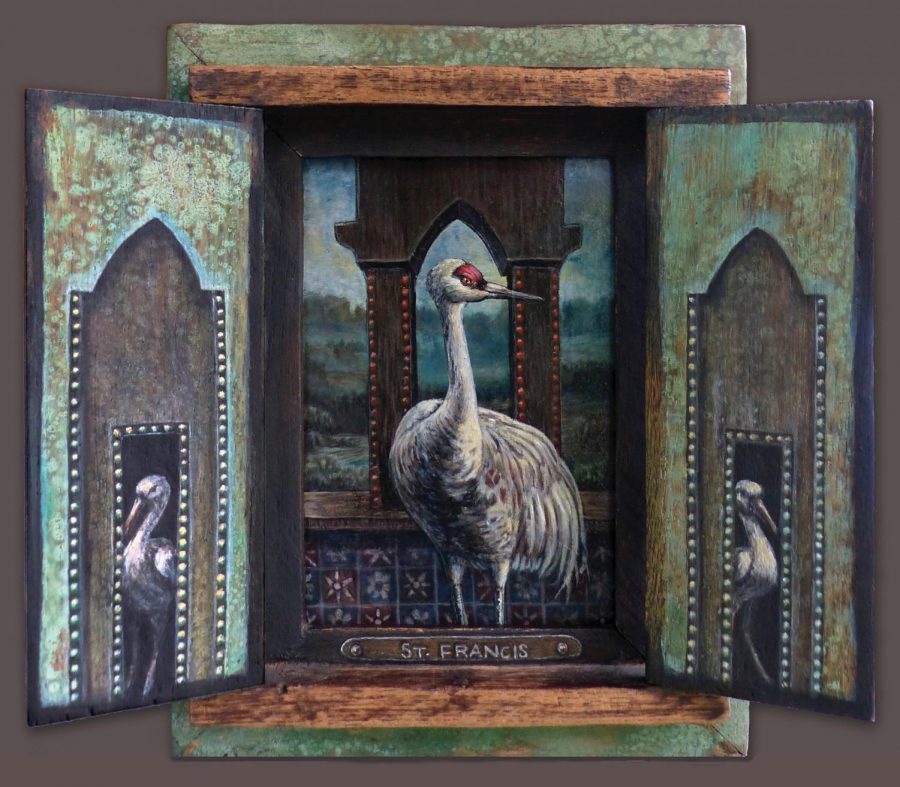Mr. Shotola Hardt’s avian elegy
This month until the 27th, Wilsonville Students will be able to see art teacher Mr. Shotola-Hardt’s show at his gallery Blackfish until the 27th. His show is titled “Elegy for the Birds” and utilizes the feathered creatures to represent ideas like family and climate change.
In his artist statement he says “Through my muted color palette, my use of taxidermy specimens, my quotations of past eras of bird illustration, my nods to art historical periods, my suggestions of historical architecture, and my observations of east European flea market relics, I hope these pieces evoke moods and associations, harken bygone epochs and Zeitgeist. Depicting endangered and extinct birds alongside common birds with my brand of mark-making and surface effects, I aim to portray my avian subjects as somewhat vulnerable and fragile.”
Shotola-Hardt’s show is a joint show with Lauren Carrera, who moved recently from San Diego to the Portland area. Her art, often sculptural, is thematically similar to Shotola-Hardt’s. He had taken notice of her art when she first joined the gallery because “Her interest in science, in environmentalism, in history, and her aesthetics were a great match for me.” He says “I knew the work would be compatible, but didn’t know it would be excellent to the degree that it is. Everyone has said that it looks like we planned everything out together, when we were just both working independently in our studios and didn’t see the other’s work until we installed the show.”
While Shotola’s art may primarily have an avian focus, his nonhuman subjects are far from superficial. “The past two shows have leaned more toward the birds, but I weave the family stuff in with them. Every show, every piece is different because I don’t repeat myself. There may be a consistent theme, but that makes sense because I’m me and my paintings and my music are the deepest ways I know to express myself. Struggling my whole life as a person who stutters, I gravitated toward those modes of expression because the speaking thing didn’t work out too well, especially early on and through my early adult life. I got bullied and I felt embarrassment and shame because of it, but when people saw my art or heard what I could do with music, they knew I had something going on.”
Unlike some artists, Shotola Hardt considers the frame a part of the piece itself and pays a painstaking amount of attention to choosing or even creating the correct frame for his work. “I always get questions about my frames because people see how perfect the matches are. I spend a great deal of time and effort making sure the relationship is just right. I have been collecting frames for many, many years, going to estate sales, antique stores, flea markets. My work has a lot of art historical references, so frames with history and frames from bygone eras are quite appropriate. Sometimes I will get materials from the lumber store and construct frames from scratch, using my painting skills to make them look like historic frames with aged patinas. Sometimes I’ll pick up a really ugly frame and my wife will ask, “What were you thinking?!?!” and I’ll say, “Just be patient,” and I’ll repair and/or alter it and make it really cool,” says Shotola-Hardt.
Shotola-Hardt doesn’t see his focus shifting anytime soon “I see these themes continuing for the foreseeable future. I haven’t expressed all I feel I need to say. The things I feel strongly about seem to be under attack nowadays: the environment (climate change deniers and global warming and other environmental crises); the refugee crisis / persecution of certain ethnic & cultural groups / human rights / racism & other types of bigotry and hatred.”











